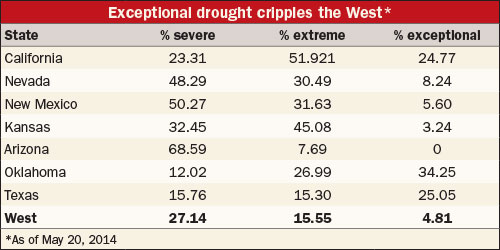
by Amanda Smith, Associate Editor
When water stops flowing, disaster ensues. Seven states, all with major agricultural sectors, are running out of water. Three of these, California, Texas and New Mexico, are top 10 milk production states. Arizona and Kansas are in the top 20, while Oklahoma and Nevada rank among the top 35.
A major portion of the U.S. is currently entrenched in weather extremes. At one end of the spectrum, the upper Midwest and East are racing against the planting clock after a soggy, chilly spring. At the other end is the West . . . bone dry with virtually no moisture in sight. With planting delays in the North and fallow land in the West, we could be in for another feed price roller coaster.
Drought is broken into three major categories: severe, extreme and exceptional. Severe is characterized by crop loss, water shortages and water use restrictions. Under exceptional drought, crop and pasture loss is widespread and shortages lead to water emergencies.
Based on U.S. Drought Monitor statistics, the seven states in the chart above have the largest land areas classified in at least a state of severe drought. In six of the seven states, more than 30 percent of the land within its boarders was classified under extreme drought. In California, Texas and Oklahoma, 24, 25 and 30 percent of the state, respectively, is classified in exceptional drought, the highest severity rating.








